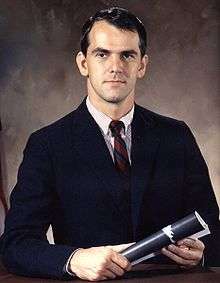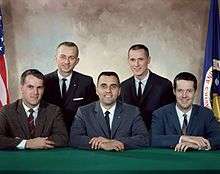Curt Michel
Frank Curtis "Curt" Michel, Ph.D. (June 5, 1934 – February 26, 2015) was an American astrophysicist; a professor of astrophysics at Rice University in Houston, Texas; a former United States Air Force pilot; and a NASA astronaut.
F. Curtis Michel | |
|---|---|
 Michel (c. mid to late 1960s) | |
| Born | Frank Curtis Michel June 5, 1934 |
| Died | February 26, 2015 (aged 80) |
| Resting place | Houston National Cemetery |
| Nationality | American |
| Other names | Curt Michel |
| Alma mater | Caltech, B.S. 1955, Ph.D. 1962 |
| Occupation | Astrophysicist, pilot |
| Space career | |
| NASA Astronaut | |
| Selection | 1965 NASA Group 4 |
| Missions | None |
| Retirement | September 1969 from Astronaut Corps |
| Awards |
|
| Scientific career | |
| Fields | Astrophysics |
| Institutions | Rice University |
| Thesis | The Beta Spectra of the Mass 12 Nuclei (1962) |
| Doctoral advisor | Thomas Lauritsen |
Personal data
Michel was born June 5, 1934, to parents to Frank and Viola Michel. He was married to Bonnie Hausman, a web technical specialist. He had two children, Alice and Jeff by his wife Beverly who predeceased him, and three grandchildren.[1] His hobbies were photography, tennis, handball, and baseball.[2] Michel died at the age of 80 on February 26, 2015.[1] He was buried with full military honors at the Houston National Cemetery.[3]
Education
Michel graduated from C. K. McClatchy High School, located at Sacramento, California, in 1951. In 1955, he received a Bachelor of Science degree with honors in physics, and in 1962 he received a doctorate in physics, both from the California Institute of Technology.[2] His thesis was "Beta Spectra of the Mass 12 Nuclei" and his dissertation advisor was Thomas Lauritsen. Nobel laureate William Alfred Fowler also served on his committee.[4]
While on the faculty of Rice University, Michel oversaw the dissertations of Jerry Modisette, Robert LaQuey, Robert Manka, Cliff Morris, Michael Pelizzari, Jürgen Krause-Polstorff, James Sokolowski, and Steven Sturner.[5]
Organizations
Michel was a fellow of the American Physical Society and a member of the American Geophysical Union, and the American Astronomical Society.[6]
Experience
Michel was a junior engineer with the Firestone Tire and Rubber Company’s guided missile division before joining the Air Force in 1955. As an AFROTC graduate, he received flight training at Marana Air Force Base, Arizona, and at Laredo Air Force Base and Perrin Air Force Base in Texas. During his three years of military service, Michel flew F-86D interceptors in the United States and in Europe (England and West Germany).[2] Michel accumulated 1,000 hours flying time with 900 hours in jet aircraft.[2]

Following his tour of active duty in the Air Force, Michel was a graduate student and research fellow at the California Institute of Technology, doing experimental and theoretical work in nuclear physics for Lauritsen and Richard P. Feynman, along with work in theoretical astrophysics for Fowler.
He joined the faculty of Rice University in Houston, Texas in July 1963. Michel's efforts there were directed at researching and teaching space sciences,[7] such as the interaction of solar winds and the lunar atmosphere.[2]
Michel was selected as a scientist-astronaut in NASA Astronaut Group 4 in June 1965.[8] He resigned from NASA in August 1969[9] without having being assigned to any spaceflight missions. Michel decided to resign after it became clear that he would not be given a flight assignment, due to the scientific community's demands that his fellow astronaut, the professional geologist Harrison Schmitt, be reassigned to Michel's position on Apollo 17 after Schmitt's planned mission on Apollo 18 was cancelled.[10]
After his resignation from NASA, Michel returned to teaching and research at Rice, where he also served as chair of the space physics and astronomy department from 1974 to 1979.[1] He was the Andrew Hays Buchanan Professor of Astrophysics from 1974 until his retirement in 2000. Michel was named a Guggenheim Fellow to the École Polytechnique in Palaiseau, France, from 1979 to 1980, and was awarded a Humboldt Prize to study in Heidelberg at the Max Planck Institute for Nuclear Physics, from 1983 to 1984. Following his retirement, Michel spent the 2001–2002 academic year in Japan at the Solar-Terrestrial Environment Laboratory of the University of Nagoya as a visiting professor.[6]
Research
Michel's research spanned many disciplines. In 1964, he predicted the existence of spin “optical rotation” due to parity nonconserving weak interactions.[11] This phenomenon was experimentally confirmed in 1980 and is used to study parity nonconserving weak interactions between neutrons and nuclei.[12] Michel is best known for his work on pulsars and neutron star magnetospheres[13] but his work also included solar wind interactions with the Moon and other bodies, extending to the heliopause. In 2000, Michel officially retired from Rice but he continued to be active in research until his death in 2015.[5]
Books
- Michel is the author of the book Theory of Neutron Star Magnetospheres, University of Chicago Press, 1990 ISBN 9780226523316.[13]
- Michel is the author of the book Handbook of High-Energy Astrophysics Experiments, Springer Verlag, 2015 ISBN 9781441965288 .
- Michel was a contributor to the book NASA's Scientist-Astronauts by David Shayler and Colin Burgess, Springer Praxis, 2007 ISBN 9780387218977
- Michel's brief career in the astronaut corps is discussed in Codex Regius (2014). The Forgotten Astronauts: A rarely told Chapter of American Spaceflight History. ISBN 978-1-4996-1012-3.
See also
References
- "Professor emeritus Curt Michel dies". Rice News and Media. February 27, 2015. Retrieved July 5, 2016.
- "Biographical Data". NASA JSC. February 11, 2015. Retrieved July 5, 2016.
- "Michel's burial". Legacy. Retrieved September 7, 2016.
- Michel, F. Curtis (January 1, 1962). Beta spectra of the mass 12 nuclei (Ph.D. thesis). Caltech. Retrieved July 5, 2016.
- "Department History". Rice University. June 12, 2015. Retrieved July 5, 2016.
- "Curt Michel Biographical Sketch". Rice University. Archived from the original on April 2, 2015.
- "Vermont Scientist May Be On Early Mission to the Moon". The Burlington Free Press. Burlington, Vermont. Associated Press. June 28, 1965. p. 1 – via Newspapers.com.
- "Six Young Scientists Become US Astronauts Today at Space Center". Lebanon Daily News. Lebanon, Pennsylvania. UPI. June 29, 1965. p. 17 – via Newspapers.com.
- "ANNOUNCEMENT OF RESIGNATION OF ASTRONAUT CURTIS MICHEL" (PDF). MSC Press Release 69-55. NASA. August 5, 1969. Retrieved April 24, 2020.
- Williams, Mike (February 27, 2015). "Professor emeritus Curt Michel dies". Rice University News & Media. Retrieved October 11, 2015.
He maintained that his decision to return to research prompted a shuffle among flight crews that led to one scientist, Harrison “Jack” Schmitt, landing on the moon with Apollo 17. “The National Academy of Sciences got all pushed out of shape when I left,” Michel said. “I think that was largely influential in Jack getting his flight. When it looked like their primary idea of getting a scientist to the moon was going to flop, they finally started pushing their weight around.” (Full interview at http://news.rice.edu/2009/07/17/from-astrophysicist-to-astronaut-and-back/)
- Michel, Curtis (January 27, 1964). "Parity Nonconservation in Nuclei". Physical Review. 133 (2B): B329–B349. Bibcode:1964PhRv..133..329M. doi:10.1103/PhysRev.133.B329.
- Forte, M. (August 1980). "Parity violation effects in neutron scattering and capture". Lettere al Nuovo Cimento. 28 (16): 538–540. doi:10.1007/BF02772925.
- Michel, Curtis (November 15, 1990). Theory of Neutron Star Magnetospheres. University of Chicago Press. ISBN 9780226523316.